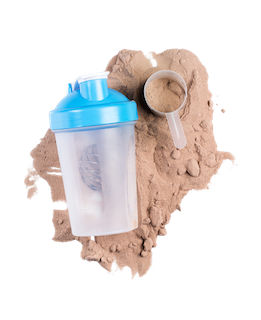Physio Hub:
Evidence-Based Article
Protein Powder
– Is It Safe?

< Key Points >
-
Regulation and Safety: Protein powders, as dietary supplements, are less regulated than pharmaceutical drugs, raising concerns about their safety and quality.
-
Variety of Products: Protein powders vary in type (concentrates, isolates) and amino acid content (complete, incomplete), with popular options like whey and casein, alongside plant-based alternatives.
-
Health Considerations: It’s important for individuals, especially those with existing health conditions, to consult with healthcare professionals before using protein powders to ensure safe consumption.
Introduction to Protein Powders and Their Rising Popularity
In the realm of fitness and health, protein powder has emerged as a popular dietary supplement, widely acclaimed for its ability to augment lean body mass and sculpt a muscular physique. The underlying science behind this belief is that protein consumption induces hyper-aminoacidemia, which in turn elevates the rate of muscle protein synthesis, suppresses muscle protein breakdown, and fosters an overall net gain in muscle protein. This promise of enhanced physical fitness has led to a surge in the marketing and consumption of various forms of protein powder. Unlike pharmaceutical drugs, which are subject to stringent safety evaluations and testing by the Food and Drug Administration (FDA) in the United States, dietary supplements such as protein powders are less rigorously regulated. Classified as special foods rather than drugs, these supplements enter the market with relative ease, deemed safe until proven otherwise. This regulatory approach, while facilitating easy access for consumers, raises critical questions about the actual safety and quality of these widely consumed products.
Diverse Types and Composition of Protein Powders
The market for protein powders is diverse, with products categorized based on their protein content and amino acid completeness. Protein powders are mainly split into two categories: protein concentrates and isolates. Protein concentrates contain a significant proportion of protein, with the remainder comprising fats and carbohydrates. In contrast, protein isolates are more refined, offering an almost pure protein content by eliminating most non-protein elements. Furthermore, protein powders are differentiated by their amino acid profiles: complete proteins, which contain all nine essential amino acids (histidine, isoleucine, lysine, methionine, phenylalanine, threonine, tryptophan, and valine), and incomplete proteins, which lack one or more of these essential amino acids. Among the plethora of options, whey and casein proteins have gained the most popularity. Whey protein, known for its affordability and rapid absorption by the body, is particularly favored for post-workout recovery. Alternatively, vegetarians and dairy-averse individuals can opt for plant-based proteins such as pea, soy, hemp, and rice proteins. This article will primarily focus on whey and casein proteins, considering their dominant presence in the protein supplement market.
Regulatory Oversight by the FDA and the Safety of Supplements
The FDA, along with the Federal Trade Commission (FTC), plays a crucial role in regulating the marketing of dietary supplements and food products. The FDA’s responsibilities include ensuring accurate product labeling and preventing the dissemination of false health claims related to the diagnosis, cure, prevention, or treatment of diseases. Manufacturers are permitted to make general health claims about their products, like being “healthy” or rich in proteins, vitamins, and minerals, without undergoing FDA review. However, if a product is found to be misleading or deceptive, the FDA has the authority to issue warning letters and take enforcement actions, which could include removing the product from the market. Despite these measures, the regulatory framework for dietary supplements remains less stringent compared to that for pharmaceutical drugs. Consequently, this leniency in regulations does not fully safeguard the public from the potential risks associated with consuming unregulated substances in food and dietary supplements. In the context of protein powders, concerns arise regarding the accumulation of toxins such as heavy metals and the use of artificial flavors and sweeteners, which carry the risk of acute and chronic toxicities, potentially leading to long-term health issues.
Addressing Safety Concerns and Providing Recommendations
The principal safety concern surrounding the consumption of protein powder is its potential impact on kidney health. Excessive protein intake is thought to increase glomerular pressure and hyper-filtration, which could lead to renal damage. However, current scientific evidence does not strongly support the notion that routine consumption of protein powder, within recommended limits, causes kidney damage. Commercially available protein powders are generally regarded as safe for consumption, but certain risk factors, such as advanced age, hypertension, heart failure, peripheral artery disease, and pre-existing kidney disease, may increase the likelihood of adverse effects. Similarly, in children and young adults, factors such as low glomerular filtration rate (GFR), proteinuria, hypertension, anemia, low birth weight, exposure to heavy metals, and metabolic disorders can heighten the risks associated with protein powder consumption. To date, there is no substantial evidence linking protein powder use with heavy metal toxicity or other severe health consequences. Nonetheless, more comprehensive research is needed to explore the long-term effects, appropriate dosages, and the impact on various age and risk groups. Given the current state of knowledge, it is imperative for individuals, particularly those belonging to at-risk categories, to seek medical advice and undergo kidney function assessments before starting any protein supplementation regimen.
< Reference >
- Churchward-Venne TA, Murphy CH, Longland TM, Phillips SM. Role of protein and amino acids in promoting lean mass accretion with resistance exercise and attenuating lean mass loss during energy deficit in humans. Amino Acids. 2013;45(2):231-240. doi:10.1007/s00726-013-1506-0
- Bowen A, Denny, Zahedi I, Bidaisee S, Keku E. The whey and casein protein powder consumption: The implications for public health. Int Public Health J. 2018;10(2).
- Boirie Y, Dangin M, Gachon P, Vasson MP, Maubois JL, Beaufrère B. Slow and fast dietary proteins differently modulate postprandial protein accretion. Proc Natl Acad Sci. 1997;94(26):14930-14935. doi:10.1073/pnas.94.26.14930
- Hoffmann D, Schwartz J. Stopping Deceptive Health Claims: The Need for a Private Right of Action Under Federal Law. Am J Law Med. 2016;42(1):53-84. doi:10.1177/0098858816644715
- Martin WF, Armstrong LE, Rodriguez NR. Dietary protein intake and renal function. Nutr Metab. 2005;2(1):25. doi:10.1186/1743-7075-2-25
- Staples A, Wong C. Risk factors for progression of chronic kidney disease. Curr Opin Pediatr. 2010;22(2):161-169. doi:10.1097/MOP.0b013e328336ebb0




